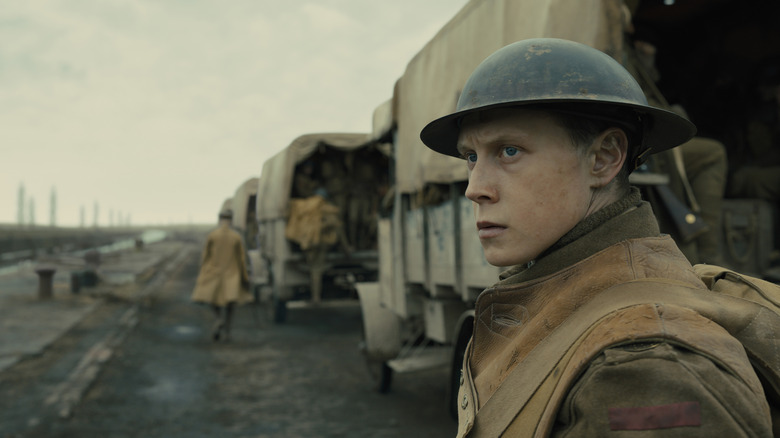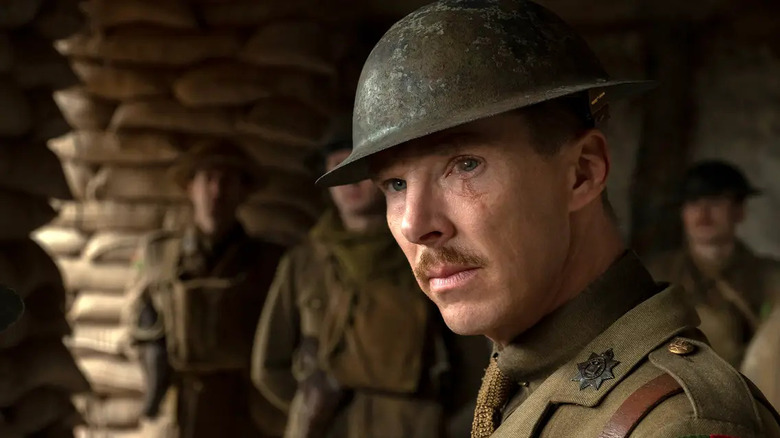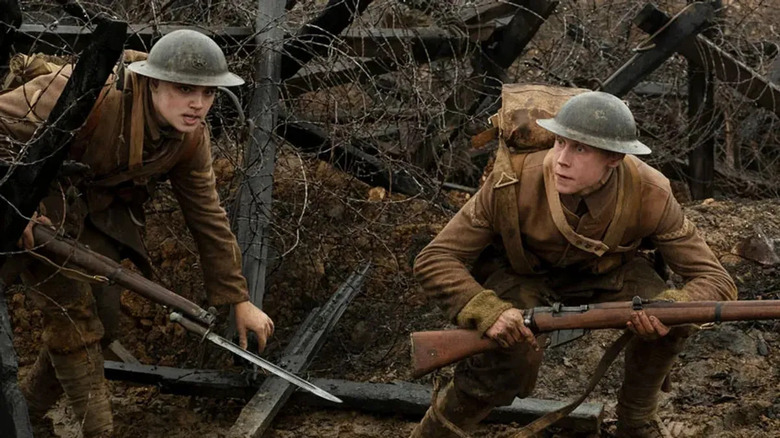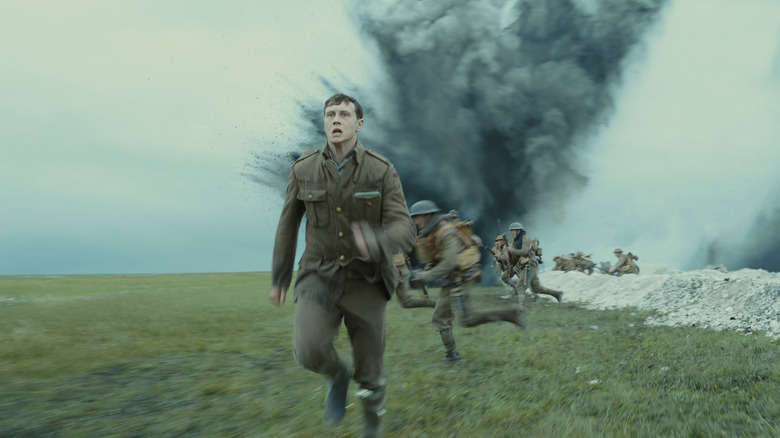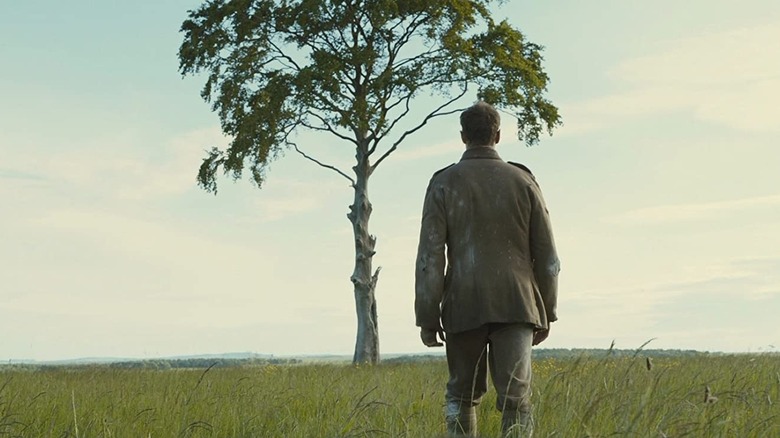1917 Ending Explained: Come Back To Us
One-shot movies have become pretty popular over the past ten years or so. It's a bold choice for any director and, at their best, shooting in real-time can create a sense of immersion or intimacy with the characters onscreen. At their worst, it feels a lot like showing off, and I personally find them a total chore to sit through. My main problem with one-shots, or film carefully edited to look like one long take, is that they feel more unnatural than lifelike. Movies, unlike real life, are normally full of cuts. Even if you're filming an event like a wedding with a video camera, chances are you'll turn the thing off occasionally and not just follow people around with it silently for two hours non-stop.
Editing has been part of the language of cinema since the silent era and cuts are the norm even in the most realistic movies. To go against this disturbs the natural rhythm of the medium, and a director deviating from this time-honored tradition only risks drawing attention to the filmmaking and camerawork instead of absorbing us in whatever the characters are doing or feeling. For me, one-shot movies are the cinematic equivalent of watching someone play a walking simulator or a first-person shooter.
Sam Mendes isn't a director who is normally given over to gimmickry but even he opted for the one-shot approach for "1917," editing the film to look like two very long takes. As a result, it suffers many of the usual distracting pitfalls of the technique, at least until we get to the end. Then the choice suddenly becomes absolutely the right one.
So what happens in 1917 again?
It is April 6, 1917, somewhere in Northern France, and two young British soldiers are summoned to receive a very important mission. The German army has pulled back from the Western Front to a defensive position called the Hindenberg Line. Aerial reconnaissance has determined that this movement of troops isn't a retreat but a tactical withdrawal and their new position is heavily fortified with artillery. Chasing after them would effectively be walking into a trap. The problem is, a British battalion is preparing an assault without this knowledge, and communication with them has been lost. The only hope is for two messengers to cross No Man's Land and deliver the order to stand down.
The two men chosen for the mission are Lance Corporal William Schofield (George MacKay), a veteran of the Battle of the Somme, and Lance Corporal Tom Blake (Dean-Charles Chapman), who has an extra incentive as his brother is among the troops readying themselves to go over the top. They are around the same age but differ considerably in their outlook: Schofield, presumably scarred by his experiences in the brutal battle where over a million men lost their lives, is closed off emotionally, while Blake is more plucky and outgoing.
On their perilous journey across the devastated wasteland, Schofield and Blake encounter many dangers: Booby traps, snipers, enemy troops, and a German pilot who fatally stabs Blake after he saves him from a burning plane. Spurred on by his friend's death, Schofield reaches the front line just as 1600 men are about to charge the German trenches. With only a few minutes to go, can he deliver the message and save hundreds of lives?
The historical context of 1917
Sam Mendes based "1917" on the war stories of his grandfather Alfred, a First World War veteran. One tale particularly inspired him; as a short man, Alfred was chosen to run messages because his diminutive stature meant he could find cover beneath the level of the low-lying mist on the battlefield (via NPR). Taking the story to the screen, the director set the action against the backdrop of Operation Alberich, the German Army's tactical retreat to the Hindenberg Line.
While Colin Firth's General Erinmore makes it clear that following the Germans would amount to falling into a deadly trap, the film doesn't really explain what it all meant in the larger context of the war.
Come early 1917, the Germans were wary of getting caught up in another devastating battle like at Verdun or the Somme, especially as they risked being outnumbered and outgunned by the combined forces of British, French, and Russian troops (via History Extra). Their solution was to fall back to the heavily fortified Hindenberg Line and regroup. This move also shaved off 30 miles of their front line, releasing more troops for defensive duties. Along the way, they laid waste to the landscape, destroying bridges, felling trees, and razing villages, making the terrain incredibly treacherous for any pursuing forces.
The strategic move was in place before several major developments that year. The Americans joined the war in April 1917 while the French were close to mutiny after a disastrous attack on the Hindenberg Line. The Russian Revolution began in March, leading to the withdrawal of their troops a year later, and more terrible battles would follow at Arras and Ypres. From the date in the film, it was another year and a half until the conflict finally came to a close in November 1918.
Going over the top
Nowadays we use the term "over the top" to describe a wide variety of reactions, but the phrase has its origins in the First World war. One of its earliest uses in print dates back to "The War Illustrated" in 1916 (via Thought Co.) describing the often futile and deadly tactic of leaving the relative safety of your trench to storm the enemy's position.
In terms of warfare, it has since become synonymous with the grim attritional nature of trench warfare during World War I and the heavy loss of life for small gains: At the Somme, the British Army lost around 420,000 advancing just seven miles (via History). When going over the top is portrayed on screen it usually means doom for the men involved, picking their way across the muddy battlefield while terribly exposed to machine guns and artillery fire.
What makes "1917" unusual is that Schofield selflessly chooses to leave the trench of his own accord to deliver the message that will save the lives of hundreds of men. Realizing his route to the Colonel who can stop the attack is blocked by many troops, the only way he can make it in time is to scramble out of the trench and sprint in the open as the first wave of the offensive begins.
This is where Mendes's decision to go with the one-take pays off, adding real dynamism to Schofield's act of heroism. It also provides a sense of exhilaration, which is a rare feeling in the usually mud-bound and static genre of World War I films. You can just see the adrenaline coursing through Schofield as artillery shells explode all around him. It's proper heart-in-the-mouth stuff, and strangely life-affirming despite the carnage going on around him.
Come back to us
After Schofield delivers the message and speaks with Blake's brother, "1917" leaves him in the same position as when we first met him, leaning against a tree and taking a well-earned rest. He has come a long way since then and his journey has changed him, particularly Blake's death.
The two men are interesting contrasts when we first see them. Blake is looser, greener, and more jovial, while Schofield is far more introspective. They contemplate a nice chicken dinner when they get their leave in a week. Blake complains that his is canceled, while Schofield says it's easier not to go back at all. That must have been a sad fact for many young men on the Front. As much as they would have yearned to see their loved ones, it must have also been unbearably hard visiting home for a short period knowing they must go back to the war, maybe never to return. It's as if battle-weary Schofield, with all his terrible experiences already, has cautioned himself against thinking too much about home anymore.
Blake's death makes the mission more personal for Schofield as he promises to find his brother and write to his mum, and he risks his own life in his determination to stop the attack. This takes on greater significance when we see the photos of his wife and children at the end; in order to do his duty and keep his promise, he had to keep his emotions locked up and be prepared never to see them again.
Written on the back of his wife's photo is, "Come back to us." He closes his eyes with the sun shining on his face. He is now ready to allow himself thoughts of home again, and the ones who love him the most.
